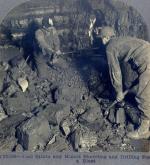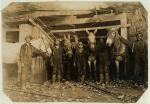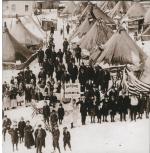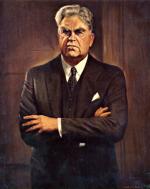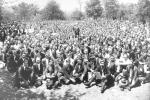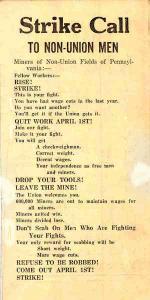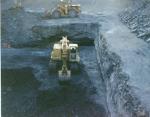Chapter 2: Working Where the Sun Never Shines
"It's dark as a dungeon and damp as the dew,
Where the danger is double and pleasures are few,
Where the rain never falls and the sun never shines,
It's dark as a dungeon way down in the mine."
Mining coal has long been dirty, dark and dangerous work. Hundreds of thousands of men and boys have labored in Pennsylvania's bituminous mines, and thousands have died to bring coal to the surface. Miners constantly faced death and injury. They also struggled with mine owners for better wages and working conditions in sometimes violent labor-management confrontations. Eventually the United Mine Workers of America (UMWA) won better pay and working conditions for miners, but it took decades of union organization, strikes and battles.
Coal mining was arduous work, especially before mechanization. Miners labored in coal seams that were two- to twenty-feet thick, and many spent the work day hunched over in narrow seams. Before mechanization they used crude hand tools and explosives to break coal from the vertical face. A skilled miner, usually lying on his side, used his pick and wedges to remove chunks of coal without shattering them. If he could not dislodge coal with his hand tools, a skilled miner drilled holes into the rock face with a hand-powered auger, placed explosives in the holes, and detonated the explosives.
Blasting coal from the rock face gradually replaced using picks and wedges, but it took considerable skill to blast coal without breaking it into fine pieces that could not be sold. Miners dislodged most coal by excavating rooms with pillars that supported the overhead roof of rock. Laborers who assisted the skilled miners shoveled dislodged coal into wooden cars, which draft animals (usually horses or mules) pulled along rails to the surface or to a mine elevator in a shaft. Boys often led the draft animals, and opened and closed tunnel doors to regulate the flow of fresh air through mines. The wooden cars delivered coal to a tipple at the surface where the coal was weighed (miners were paid by the weight of coal they dug) and often sorted by size.
Operators steadily adopted machinery to boost miners' productivity, replace workers, and cut labor costs. Mechanization also decreased the need for skilled miners, thus diminishing the control and autonomy that skilled miners had enjoyed in the work place. Operators first adopted machines that undercut the rock face, greatly reducing the hand labor needed to break the rock face into smaller pieces that could be hauled to the surface. By World War II almost all bituminous coal was undercut mechanically. During the 1930s and 1940s mining companies switched from hand loading to mechanical loading. Miners who had filled mine cars by hand called mechanical loaders "man killers," because the machinery put miners out of work.
Coal mining, whether by hand or machine, was deadly work. All 109 miners who entered the Mammoth Mine on January 27, 1891, died in an explosion (see
Miners also demanded better pay and working conditions, beginning in the mid-nineteenth century. Between 1861 and 1890 bituminous miners joined a series of short-lived unions to win pay raises, better working conditions, and shorter work days. They also staged increasingly violent strikes against operators, culminating in the 1891
Miners formed the UMWA in 1890 to gain power and win their demands. The UMWA fought for decades to obtain its initial goals of higher earnings, safe mining practices, and an eight-hour work day. In 1897 the UMWA won a nationwide bituminous strike and gained the eight-hour day and operators' recognition of the union as the collective bargaining agent for many miners in western Pennsylvania, Ohio, Indiana, and Illinois (see
The UMWA cause met both disaster and success during the 1920s and 1930s. The union defended its 1919 gains during a nationwide strike in 1922, but in settling the strike the UMWA ignored nearly 70,000 nonunion miners who had joined the strike. Nonunion miners, including immigrants in Windber, continued the strike well into 1923 to win union recognition and pay raises, but they lost (see
Union membership dropped to 84,000 in 1929. However, salvation for the UMWA came in 1933 with passage of the National Industrial Recovery Act, which sanctioned collective bargaining as part of industry codes. This act prompted an enormous organizing campaign by the UMWA and membership soared to 400,000 in 1934. The union also made major gains in wages and working conditions during the later 1930s.
Lewis and the UMWA achieved significant benefits for miners after World War II, but he and his successors also fostered growing autocracy and corruption in the union. The strong-willed Lewis centralized power into his own hands, building an autocratic union bureaucracy that neglected the grievances of rank-and-file members. After Lewis retired in 1960, his successors as president, including Tony Boyle, reinforced autocratic rule, and Boyle illegally siphoned off union money to stay in power.
The ensuing scandal and court trial sent Boyle to prison for the rest of his life and led to elections in 1972 that brought new leaders to the union; however, new leadership could not stem the flow of workers out of Pennsylvania bituminous mines. The industry had been in decline since the 1920s, and the number of miners fell from 182,000 in 1918 to just over 10,000 in 1993 (see








